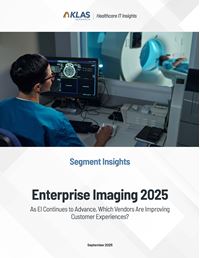 2025 BEST IN KLAS
2025 BEST IN KLAS
Preferences
Related Series
Related Segments


Enterprise Imaging 2021
Are Any Solutions Ready for Broad Market Adoption?
KLAS estimates that just over 200 organizations in the US are live with enterprise imaging (EI) technology, defined here as the ability to store and/or view images across the enterprise from more than one service line, PACS, or long-term storage solution. KLAS interviewed leaders from 138 of the deepest adopting organizations (over 60% of all organizations live) to gain insights into their experience. A single question guided the interviews: Is EI technology ready for broad adoption by the market at large? By examining recent go-lives, customer-reported ROI, and vendor’s strategic ability, this report identifies each vendor’s proof points of success and reasons for caution, seeking to determine which vendors are best poised to meet needs as EI adoption expands.
Track Records of Agfa, Fujifilm, Hyland, IBM Indicate They Are Most Ready for Future EI Adopters—but Not without Caveats
As the EI market continues to develop, four vendors—Agfa HealthCare, Fujifilm, Hyland, and IBM Watson Health—stand out with more proven track records, meaning KLAS was able to interview 10+ customers and validate strong proof points of success. These four vendors have widely different strengths, and all have progress yet to make (see table below).

Agfa HealthCare Sees the Most—and the Most Satisfied—Recent Go-Live Validations
The prevalence of newly live customers (live <24 months) and the satisfaction of these customers are key indicators as to whether a solution is ready for broad adoption. KLAS validated the most go-lives for Agfa HealthCare, and these customers (who include some migrations from legacy Agfa solutions) describe well-coordinated go-lives and excellent technology. Conversely, IBM Watson Health customers report significant go-live struggles, including lack of organization and lack of some functionality promised in the sales demo.
KLAS validated one new go-live for Mach7 Technologies and none for Philips or NTT DATA. While many Sectra PACS customers are new to the Sectra VNA, these organizations do not consider themselves net-new go-lives since they view the VNA as an add-on to their existing Sectra PACS technology.

IBM Watson Health Leads in Scalability; Small Philips Customers Report Positive ROI

Regardless of the vendor in use, 53% of respondents report a positive return from their EI investment; the specifics tend to be soft (not fully quantified) and usually center on improved clinician satisfaction with imaging workflows and accessibility. Respondents with more concrete ROIs usually talk about being able to discontinue displaced systems and increase physician productivity, in radiology and beyond.
Larger organizations, which leverage their solutions far more than traditional department solutions, face more complex implementations and a longer ramp-up to value. While IBM Watson Health is average to below average in the percent of customers reporting an ROI, many of their largest customers indicate they are a standout for scalability. This includes several very large health systems who report good response times with a single instance of the IBM solution. Smaller organizations are far more likely to report an ROI from their EI investment, possibly in part because leaders at these organizations might be better positioned to observe the soft ROIs achieved or because, requiring less lift, EI projects at these organizations progress faster. Philips customers, who are on average the smallest interviewed in this report, overwhelmingly report a positive ROI, though on a much smaller scale; customers say they have been able to consolidate solutions by adding cardiology images to their traditional archive.
Agfa HealthCare, Philips, GE Healthcare, IBM Watson Health Best at Providing Strategic Guidance
Strategic guidance is not easy to deliver—especially in large, complex settings—but it is critical for EI success; this is true for organizations new to EI and those expanding existing capabilities. What qualifies as strategic guidance varies among organizations, with larger organizations often needing greater help with governance, change management, and long-term vision. Agfa HealthCare, Philips, GE Healthcare, and IBM Watson Health customers say their vendors try to help strategically. Conversely, Fujifilm customers—who are usually only using Fujifilm’s VNA—describe their vendor as focused mostly on the technology. Hyland customers are nervous about the vendor’s ability to provide strong guidance and a hands-on approach. Some customers feel supported by Hyland’s imaging team but do not feel the vendor has given the solutions (acquired by Hyland) the full attention they need.

Referential Viewing—GE Customers Often Using Third Party or Not Adopting at All
Depending on an organization’s overall goals, referential viewing can provide great value and improve physician productivity. While most vendors have some customers who report strong adoption of this capability, only 50% of interviewed GE Healthcare customers use GE’s universal viewer for referential viewing, with some using third-party viewers instead.

Vendor Summaries
See above for summaries of Agfa HealthCare, Fujifilm, Hyland, and IBM Watson Health

About This Report
Each year, KLAS interviews thousands of healthcare professionals about the IT products and services their organizations use. These interviews are conducted using a standard quantitative evaluation, and the scores and commentary collected are shared in reports like this one and online in real time so that other providers and IT professionals can benefit from their peers’ experiences. To enable readers to more quickly understand high-level differences in vendor performance and give better context as to how each product compares to other offerings in the market, KLAS has organized the questions from the standard evaluation into six customer experience pillars—culture, loyalty, operations, product, relationship, and value.

To supplement the data gathered with this standard evaluation, KLAS also creates various supplemental evaluations that target a subset of KLAS’ overall sampling and delve deeper into the most pressing questions facing healthcare technology today.
The data in this report comes from both evaluation types and was collected over the last 12 months; the number of unique responding organizations for each solution and evaluation type is given in the chart below.

What Does “Limited Data” Mean?
Some products are used in only a small number of facilities, some vendors are resistant to providing client lists, and some respondents choose not to answer particular questions. Thus a vendor’s sample size may vary from question to question and may not reach KLAS’ required threshold of 15 unique respondents. When a vendor’s sample size for a particular question is less than 15, the score for that question is marked with an asterisk (*) or otherwise designated as “limited data.” If the sample size is less than 6, no score is shown. Note that when a vendor has a low number of reporting sites, the possibility exists for KLAS scores to change significantly as new surveys are collected.
Overall scores are measured on a 100-point scale and represent the weighted average of several yes/no questions as well as other questions scored on a 9-point scale.

Writer
Elizabeth Pew

Designer
Madison Moniz

Project Manager
Natalie Jamison
This material is copyrighted. Any organization gaining unauthorized access to this report will be liable to compensate KLAS for the full retail price. Please see the KLAS DATA USE POLICY for information regarding use of this report. © 2025 KLAS Research, LLC. All Rights Reserved. NOTE: Performance scores may change significantly when including newly interviewed provider organizations, especially when added to a smaller sample size like in emerging markets with a small number of live clients. The findings presented are not meant to be conclusive data for an entire client base.














